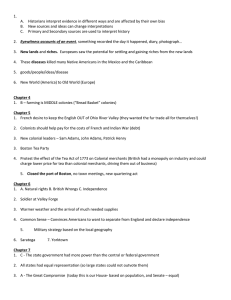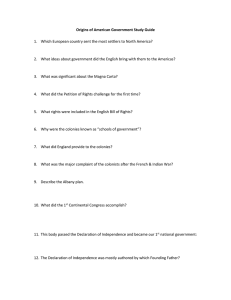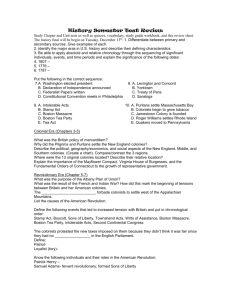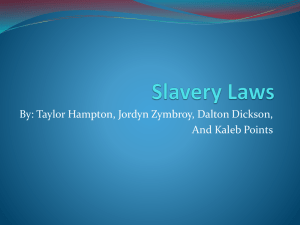8 Grade American History: Midterm Exam Study Guide
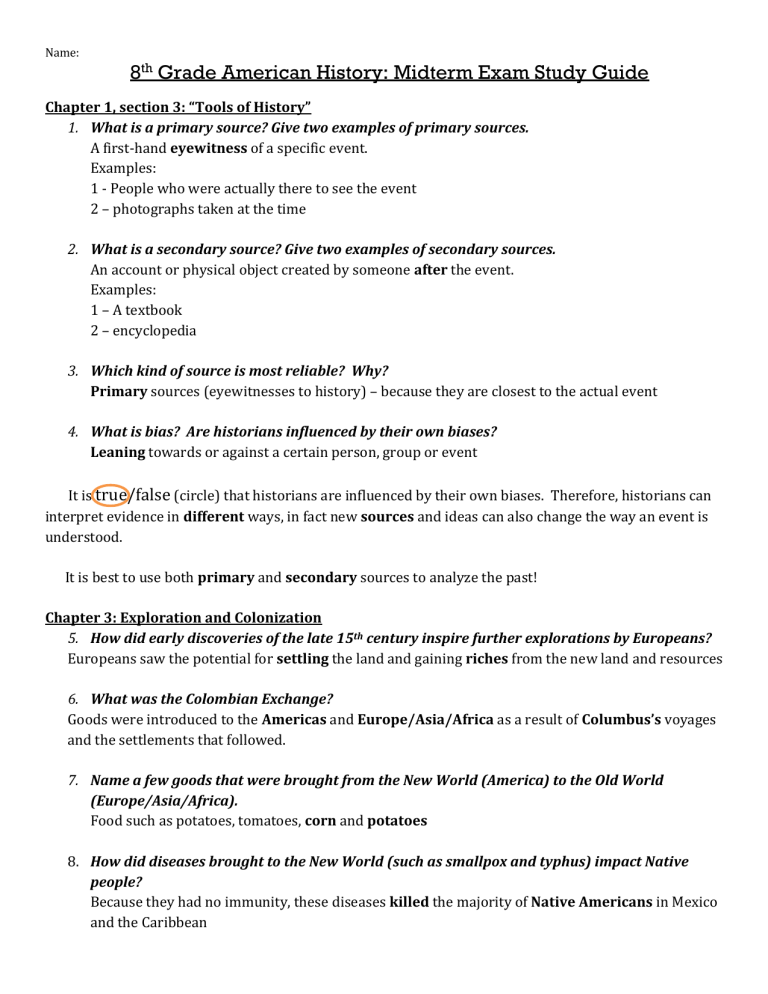
Name:
8
th
Grade American History: Midterm Exam Study Guide
Chapter 1, section 3: “Tools of History”
1.
What is a primary source? Give two examples of primary sources.
A first-hand eyewitness of a specific event.
Examples:
1 - People who were actually there to see the event
2 – photographs taken at the time
2.
What is a secondary source? Give two examples of secondary sources.
An account or physical object created by someone after the event.
Examples:
1 – A textbook
2 – encyclopedia
3.
Which kind of source is most reliable? Why?
Primary sources (eyewitnesses to history) – because they are closest to the actual event
4.
What is bias? Are historians influenced by their own biases?
Leaning towards or against a certain person, group or event
It is
true/false
(circle) that historians are influenced by their own biases. Therefore, historians can interpret evidence in different ways, in fact new sources and ideas can also change the way an event is understood.
It is best to use both primary and secondary sources to analyze the past!
Chapter 3: Exploration and Colonization
5.
How did early discoveries of the late 15 th century inspire further explorations by Europeans?
Europeans saw the potential for settling the land and gaining riches from the new land and resources
6.
What was the Colombian Exchange?
Goods were introduced to the Americas and Europe/Asia/Africa as a result of Columbus’s voyages and the settlements that followed.
7.
Name a few goods that were brought from the New World (America) to the Old World
(Europe/Asia/Africa).
Food such as potatoes, tomatoes, corn and potatoes
8.
How did diseases brought to the New World (such as smallpox and typhus) impact Native
people?
Because they had no immunity, these diseases killed the majority of Native Americans in Mexico and the Caribbean
Chapter 4: The Thirteen Colonies
9.
Briefly describe the geography/climate and economy (how people make a living) of the three colonial regions: a.
New England – harsh winters, rocky soil, logging a main economic activity b.
Middle – mild winters and fertile soil, most make their living farm c.
Southern – long growing season, cash crops that used slave labor
Chapter 5: Road to the Revolution
10.
What was the major reason for conflict between the British and French in the Ohio River
Valley?
French determination to halt (stop) westward expansion by the English.
11.
What reason did the British Parliament give for raising taxes in the colonies after 1763?
Colonist should help pay for the costs of the French and Indian war
12.
What was the main reason the colonists opposed the taxes?
They were not represented in the British Parliament
13.
Name some of the new colonial leaders that emerged as tensions with Britain grew.
1) Sam Adams 2) John Adams 3) Patrick Henry
14.
What was the goal of the Boston Tea Party? (What were they protesting?)
To protest the effect of the Tea Act of 1773 on colonial tea merchants (it gave the British company a monopoly on the tea trade) “Boston harbor is a teapot tonight!” - Sons of Liberty
15.
How did the Intolerable Acts punish Massachusetts after the Boston Tea Party? Describe the specifics.
1 - Parliament shut down the ports of Boston (until all tea was paid for)
2 – British soldiers were housed in colonist’s homes (Quartering)
3 – British officials could not be tried in Massachusetts (trial for crimes in England)
Chapter 6: The American Revolution
16.
What are the three main ideas or parts of the Declaration of Independence?
1 – Natural Rights 2 - British Wrongs 3 - Independence
17.
Which document convinces Richard Henry Lee to make the motion in the Second Continental
Congress that called for the colonies to separate from Britain?
Common Sense by Thomas Paine
18.
Why was Saratoga a turning point battle? It prompted the French to join the Patriots.
19.
Briefly describe the conditions at Valley Forge.
Sick soldiers, poor food, cold weather, poor lodging
20.
In addition to warm weather, what else helped ease the harsh conditions?
The arrival of much needed supplies
21.
Which strength of the Continental Army was significant to its ultimate victory?
Military strategy based on local geography
22.
What was the significance of the Battle of Yorktown?
Led to the end of the Revolutionary War
Chapter 7: Creating a Republic
23.
What was the main weakness of the Articles of Confederation?
State governments had more power than the central government
24.
How did the New Jersey Plan and Virginia Plan Differ?
New Jersey: One house legislature based on equal representation
Virginia: Two house legislature with representation based on population
25.
What was the Great Compromise? How is this represented in today’s Congress?
It resolved the conflict between the Virginia plan and the New Jersey plan over representation in the legislature
Big states favored the Virginia plan - based on population today this is the House of Representatives
Small states favored the New Jersey plan – all states would have equal representation, today this is the
Senate
26.
Which group advocated for a Bill of Rights? Why?
Anti-Federalists because they believed the Constitution must spell out ways to protect people’s basic
rights
27.
How did the Bill of Rights become a part of the Constitution? What must occur for an amendment to become law?
It was added through the amendment process, after it is proposed, it must be ratified by 3/4 of the
state legislatures.
Chapter 8: The Constitution
28.
What are the six goals listed in the Preamble?
We the people….
In order to form a more perfect union, establish justice, ensure domestic tranquility, provide for the
common defense promote the general welfare, and secure the blessings of liberty to ourselves and our posterity do ordain and establish this Constitution for the United States of America
29.
What are the main roles of the three branches of government? a.
Executive – President - carries out the nation’s laws – checks on power: can veto laws, can make appointments (give jobs to judges or executive departments) b.
Legislature – Writes the nation’s laws - checks on power: can override a veto, can ratify
treaties (agreements with other nations) and can impeach (to charge a government official with a crime) c.
Judicial – Decides if laws are good (and if they follow the Constitution)– checks on power:
The Supreme Court can declare a law unconstitutional
30.
What is federalism? What is one power the federal government has that the state’s do not?
Who controls public education?
*When government power is shared between the states and the central government
*Central or federal government has the power to declare war, coin money
*State governments control public education
31.
What is the function of the Articles, or main body, of the Constitution?
To establish the framework of government
32.
What are some of the rights given in the Bill of Rights?
Freedom of religion, freedom of speech, right to bear arms (weapons)
33.
Name three of your civic responsibilities.
obey the law, serve on a jury, being informed (educated!)
